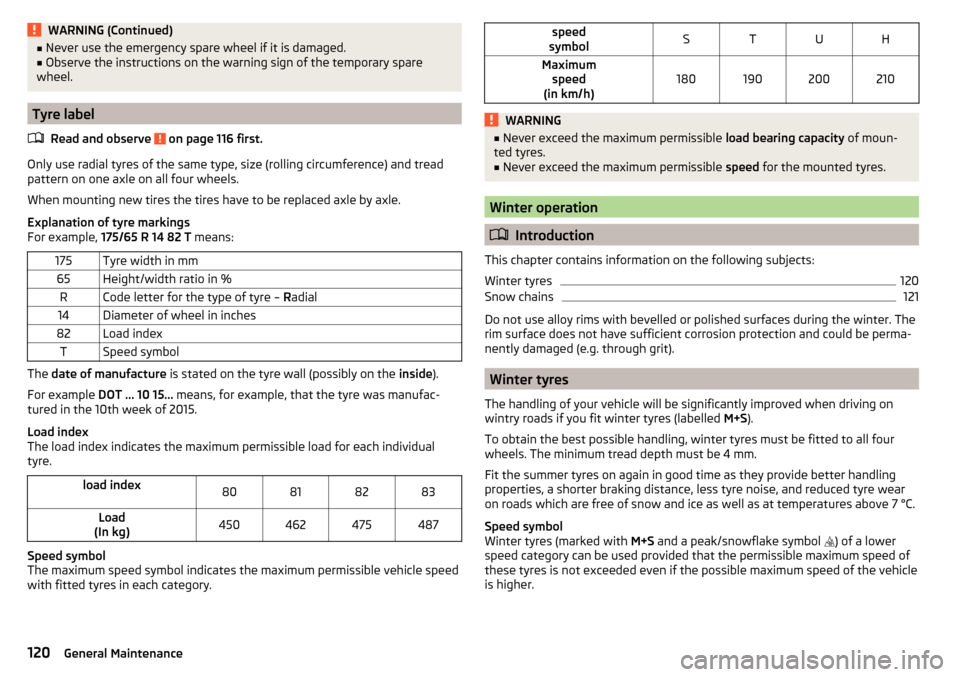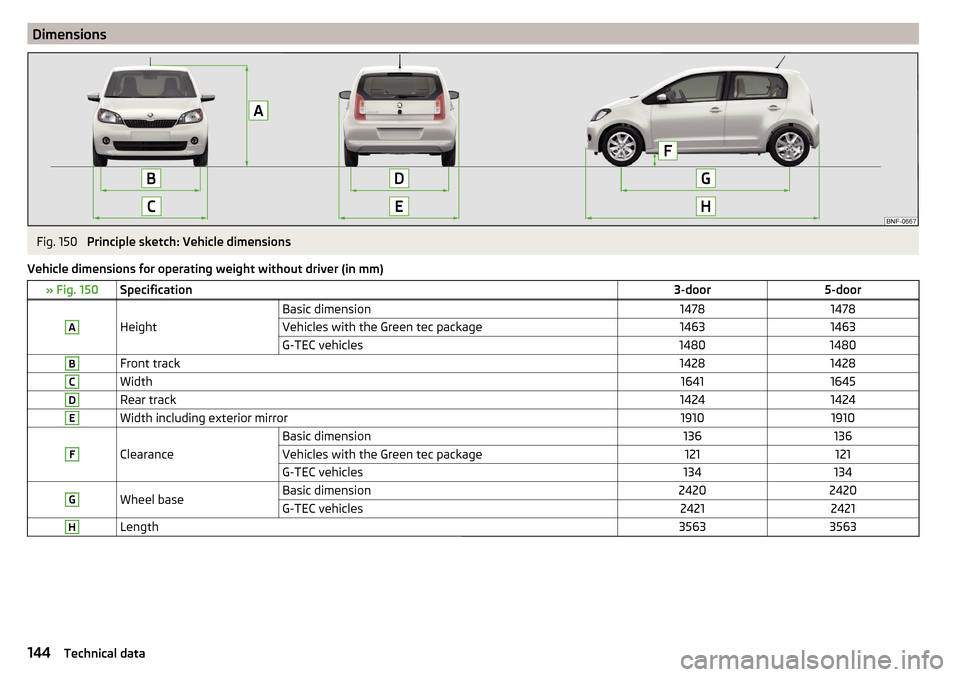width SKODA CITIGO 2015 1.G Owner's Manual
[x] Cancel search | Manufacturer: SKODA, Model Year: 2015, Model line: CITIGO, Model: SKODA CITIGO 2015 1.GPages: 160, PDF Size: 23.1 MB
Page 49 of 160

Lights and visibility
Lights
Introduction
This chapter contains information on the following subjects:
Operation of the light function
47
Daylight running lights (DAY LIGHT)
48
Turn signal and main beam
48
Front and rear fog light
49
Hazard warning light system
49
Parking light
49
Driving abroad
50
Unless otherwise stated, the lights only work when the ignition is on.
The arrangement of the controls right-hand drive models may differ from the layout shown in » Fig. 40 on page 47 . The symbols which mark the positions
of the controls are identical.
WARNING■ The driver is always responsible for the correct settings and use of the
lights.■
Never drive with only the side lights on! The side lights are not bright
enough to light up the road sufficiently in front of you or to be seen by oth-
er oncoming traffic. Therefore always switch on the low beam when it is
dark or if visibility is poor.
Note
■ The instruments are also illuminated when the side light or low beam light is
switched on.■
The headlights may mist up temporarily. When the driving lights are switched
on, the light outlet surfaces are free from mist after a short period, although
the headlight lenses may still be misted up in the peripheral areas. This mist
has no influence on the life of the lighting system.
Operation of the light functionFig. 40
Light switch / Knob for headlamp
beam adjustment
Read and observe on page 47 first.
Switching lights on and off
Depending on the equipment configuration, the light switch
A
» Fig. 40 can
be turned to one of the following positions.
Switching off lights (except daytime running lights)
Switch on daytime running lights and side lights or parking lights
» page 49
Turn on the low beam
Headlight range control
By turning the rotary switch
B
» Fig. 40 from position
to
, the headlight
range control is gradually adjusted, thereby shortening the light cone.
The positions of the width of illumination correspond approximately to the fol-
lowing car load.
Front seats occupied, boot empty
All seats occupied, boot empty
All seats occupied, boot loaded
Driver seat occupied, boot loaded
WARNINGAlways adjust the headlight beam to meet the following conditions.■The vehicle does not dazzle other road users, especially oncoming vehi-
cles.■
The beam range is sufficient for safe driving.
47Lights and visibility
Page 122 of 160

WARNING (Continued)■Never use the emergency spare wheel if it is damaged.■Observe the instructions on the warning sign of the temporary spare
wheel.
Tyre label
Read and observe
on page 116 first.
Only use radial tyres of the same type, size (rolling circumference) and treadpattern on one axle on all four wheels.
When mounting new tires the tires have to be replaced axle by axle.
Explanation of tyre markings
For example, 175/65 R 14 82 T means:
175Tyre width in mm65Height/width ratio in %RCode letter for the type of tyre – Radial14Diameter of wheel in inches82Load indexTSpeed symbol
The date of manufacture is stated on the tyre wall (possibly on the inside).
For example DOT ... 10 15... means, for example, that the tyre was manufac-
tured in the 10th week of 2015.
Load index
The load index indicates the maximum permissible load for each individual
tyre.
load index80818283Load
(In kg)450462475487
Speed symbol
The maximum speed symbol indicates the maximum permissible vehicle speed
with fitted tyres in each category.
speed
symbolSTUHMaximum speed
(in km/h)180190200210WARNING■ Never exceed the maximum permissible load bearing capacity of moun-
ted tyres.■
Never exceed the maximum permissible speed for the mounted tyres.
Winter operation
Introduction
This chapter contains information on the following subjects:
Winter tyres
120
Snow chains
121
Do not use alloy rims with bevelled or polished surfaces during the winter. The
rim surface does not have sufficient corrosion protection and could be perma-
nently damaged (e.g. through grit).
Winter tyres
The handling of your vehicle will be significantly improved when driving on
wintry roads if you fit winter tyres (labelled M+S).
To obtain the best possible handling, winter tyres must be fitted to all four
wheels. The minimum tread depth must be 4 mm.
Fit the summer tyres on again in good time as they provide better handling
properties, a shorter braking distance, less tyre noise, and reduced tyre wear
on roads which are free of snow and ice as well as at temperatures above 7 °C.
Speed symbol
Winter tyres (marked with M+S and a peak/snowflake symbol
) of a lower
speed category can be used provided that the permissible maximum speed of
these tyres is not exceeded even if the possible maximum speed of the vehicle
is higher.
120General Maintenance
Page 146 of 160

DimensionsFig. 150
Principle sketch: Vehicle dimensions
Vehicle dimensions for operating weight without driver (in mm)
» Fig. 150Specification3-door5-doorA
Height
Basic dimension14781478Vehicles with the Green tec package14631463G-TEC vehicles14801480BFront track14281428CWidth16411645DRear track14241424EWidth including exterior mirror19101910F
Clearance
Basic dimension136136Vehicles with the Green tec package121121G-TEC vehicles134134GWheel baseBasic dimension24202420G-TEC vehicles24212421HLength35633563144Technical data
Page 156 of 160

Checking the battery electrolyte level114
Operation in winter114
Safety instructions112
Vehicle care Alcantara
101
Anodized parts98
Artificial leather101
Cavity protection99
Chrome parts98
Cleaning vehicle exterior96
Cleaning wheels99
Decorative and protective films97
Door locking cylinder99
Headlight glasses98
Interior care100
Maintenance97
Materials101
Natural leather100
Plastic parts98
Polishing the vehicle paintwork97
Rubber seals98
Safety belt102
Seat covers101
Under-body protections99
washing95
Vehicle data sticker142
Vehicle data sticker and nameplate Vehicle data sticker and nameplate
142
Vehicle dimensions144
Vehicle height144
Vehicle Identification Number (VIN)142
Vehicle length144
Vehicle tool kit122
Vehicle width144
vest Positioning of the reflective vest
122
VIN Vehicle Identification Number
142
Visibility50
Visors see Sun visors51
Visual parking system87
W
Warning at excessive speeds
32
Warning lights34
Warning symbols34
Warning triangle122
Washing Automatic car wash system
96
by hand95
Washing the vehicle Pressure Washer
96
Washing vehicles95
Waste container59
Weather conditions92
Wheel bolts Anti-theft wheel bolts
124
Caps124
Loosening and tightening125
Wheel rims116
Wheels Age of wheels
116
Changing123
Driving style118
Full trim124
General information116
Load index120
Snow chains121
Speed symbol120
Storage of wheels116
stow123
take out123
Tyre damage119
Tyre pressure117
Tyre size120
Tyre wear118
Tyre wear indicator118
Unidirectional tyres119
Wheel balance118
Wheel replacement118
Winter tyres120
Window wiper Replacing the rear window wiper blade
134
Windscreen washer fluid Checking
108
Replenishing108
Winter108
Windscreen washer system108
Windscreen washer system52
Windscreen wipers Replacing the windscreen wiper blades
133
Servicing position for the windscreen wiper arms
133
Windscreen washer fluid108
Windscreen wipers and washers51
Winter operation120
De-icing windows98
Snow chains121
Winter tyres120
Winter tyres See Wheels
120
Wiper blades100
Wiper interval52
Wipers Maintaining wiper blades
100
154Index